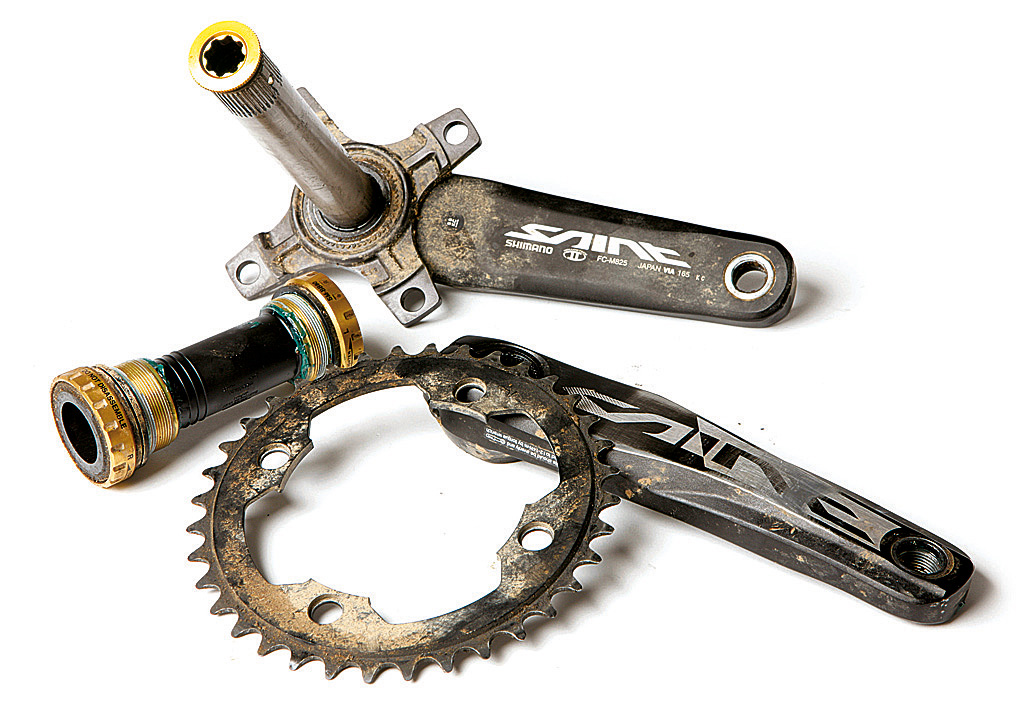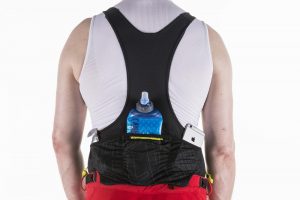Shimano Saint groupset review
Now in its third life cycle, Shimano’s Saint groupset is moving further away from its freeride origins to focus purely on gravity racing. The latest shift sees some weight reduction, refined technology and a few new additions. Unfortunately the eagerly awaited Saint chain device, with its articulated lower guide, and the new cooling fin IceTech rotors, weren’t ready in time for the 2013 product launch.
Everything else was good to go so we didn’t let that get in the way of pressure testing all of the other parts with 157,000ft of descending in Whistler bike park. With 3,346ft of elevation in the lower section alone, that equates to 130 runs, roughly equivalent to three or four months of testing in the UK. The weather mirrored typical conditions back home, so in many ways this is more of a reliability test of the new Shimano Saint, not simply a first ride.
The groupset
Weight: 495g
The newest additions to the Saint groupset are the two-tone MX80 flat pedals. Traction pins screw in from the underside of the pedal body to make them easier to remove when damaged and the pins have pre-installed washers that can be removed for fine-tuning the pin height.
There are no raised sections around the axle to annoy and while the Saint pedals don’t feel quite as comfortable as a double concave design, they offer plenty of grip even with the shortest pin height. At 495g the MX80s are on the heavy side, but if the spindles are half as durable as Shimano’s SPD pedals, they will have no reliability issues.
Saint M820 brakes, £194.99 (no rotor or adapter)
Weight: 300g front, 307g rear
While the four-piston caliper is new, the Saint levers are a combination of existing Shimano components: XTR Trail lever bodies with SLX blades. The idea is that the rolled, rather than cast, SLX lever blade will bend instead of breaking in a crash, allowing the racer to finish their run.
Lever position and profile of the new Saint brakes are both spot-on (providing you don’t middle-finger brake) and the action is definitely less grabby than the previous design. The Servo-Wave lever, however, generates a lot of initial lever stiction which leads to an inconsistent lever feel, especially in wet conditions. Given the chance, we’d like to try the new Saint caliper with the non-Servo-Wave XTR Race levers.
Saint M820/M825 hubs, £69.99 front/£119.99 rear
Weight: 213g (20mm front), 362g (150mm x 12mm rear)
Not much has changed here and Shimano is sticking to its guns on the virtues of the traditional cup and cone bearing design. It’s a bit like suspension engineers telling us that bushings are superior to cartridge bearings for suspension pivots, when everyone knows that the opposite is true.
From new, the Saint hubs had a lot of seal drag, and while they definitely didn’t spin as freely as Hope or DT Swiss hubs, at least the bearings felt smooth and the 10° freehub engagement reassuringly solid.
Seven days later and at the end of another wet stint in the bike park, we happened to notice that the rear hub was dry and dusty, just like the shock reservoir and brake calipers. Heat was obviously being generated in the hub, and when we removed the rear wheel we struggled to turn the rear axle with our fingers. We reset the cones, but it was too late, the damage was already done and the bearings felt indexed. In the product presentation Shimano told us that it had dropped the replaceable bearing cup feature, so these hubs will probably end up in the bin.
Given their weight, the Saint hubs need to be bombproof, but they clearly aren’t — the front hub also started to feel ropey by the end of the trip. Saint hubs are available in both 32 and 36-hole drillings.
Saint M820 SS rear mech £139.99
Weight: 274g
Three key features of the new Saint rear mech make it great. First, the Shadow design helps keep it tucked under the rear dropout and out of harm’s way. It doesn’t seem like a big deal, but when you see Saint side-by-side with a SRAM rear mech it’s definitely less exposed.
Second, Shadow Plus technology stops the lower portion of the chain from flapping around to reduce chain slap and derailment. Unfortunately it also makes the shift action heavier as you move up the cassette (more pronounced on wide ratio cassettes) but it’s an acceptable trade-off.
My favourite design feature and probably the easiest for Shimano to implement across its rear mech range is the addition of a rubber bumper on the b-knuckle pivot of the mech that stops it knocking.
Even with all of this technology the bike was never as silent as the very first day we rode it, even after Shimano reset the tension in the Shadow Plus mechanism. Maybe you just can’t beat a fresh chain.
Weight: 134g
For us, the most impressive part of the 2013 Saint Groupset is the new shifter pod. It’s basically a modified XTR shifter with longer, more ergonomically designed paddles. To prevent the longer shift levers from binding, they rotate on bearings and the result is light, snappy shifting every time. It didn’t take long to get used to the double down shift and it is ideal for dumping gears as you drop in at the start of a trail and quickly pick up speed. Even the single down shift feels more positive than current XTR.
According to Shimano this is the first shifter corrected for Shadow Plus derailleurs so it doesn’t get stiffer as you shift up the cassette. In reality it does get stiffer, but it’s not as pronounced as on XTR.
Saint M825 chainset £239.99 (no chainring)
Weight: 736g (165x83mm, no chainring, bolts or BB)
Saint BB £39.99
Weight: 96g (83mm shell)
Shimano’s chainsets are second to none, not least because they are the only two-piece design that lets you accurately preload the BB. It’s pretty much an Aheadset system turned on its side, and combined with the hollow-forged arms they are the benchmark design in every category.
For 2013 Shimano has shaved 100g off the chainset and at mere 736g (no BB or chainring) it’s claimed to be 250 per cent stronger than XTR. One major difference, however, is that the Saint unit doesn’t taper towards the BB for improved heel clearance. In fact, it’s pretty square and we found that we had to reposition our feet on the pedals to stop our heels catching on the crankarms. Even with that, the outside edge of the cranks were polished smooth within a couple of days. To stop the cranks looking tatty after one wet ride we’d like to see them polished as standard, just like XTR, or at the very least they should come with heli-tape pre-installed.
Saint chainrings are available separately in 34/36/38t sizes for £59.99. For the record the 36t ring weighs 66g.
Verdict
Does anyone really need 10 gears on a downhill bike? We certainly don’t and we’d be very surprised if Aaron Gwinn or Gee Atherton used all 10 gears at a World Cup DH race.
So, impressive as the new Saint shifter and rear mech are, we’d like to see Shimano take the Saint groupset several steps further.
Shimano is already making specific hubs, cranks, a shifter and rear mech, so what’s stopping it from doing something unique with Saint, like a six or seven-speed transmission?
Specialized has proved that having fewer gears on a downhill bike has several advantages, but it’s a limited edition set-up using a mix of SRAM, Shimano and custom DT Swiss components.
Wouldn’t it be great if anyone could just walk into a store and buy a similar set-up? We don’t even think it would be that difficult for the mighty Shimano to implement. It’s the only company currently producing a dedicated gravity transmission, so why not make the focus even tighter?
This review first appeared in the New For 2013 series in the August issue of MBR, alongside the Specialized Camber 29, Stumpjumper Expert Evo, SRAM xx1 drivetrain and Commencal Meta SL Ltd.
Photos: Sterling Lorence and Mike Prior



















